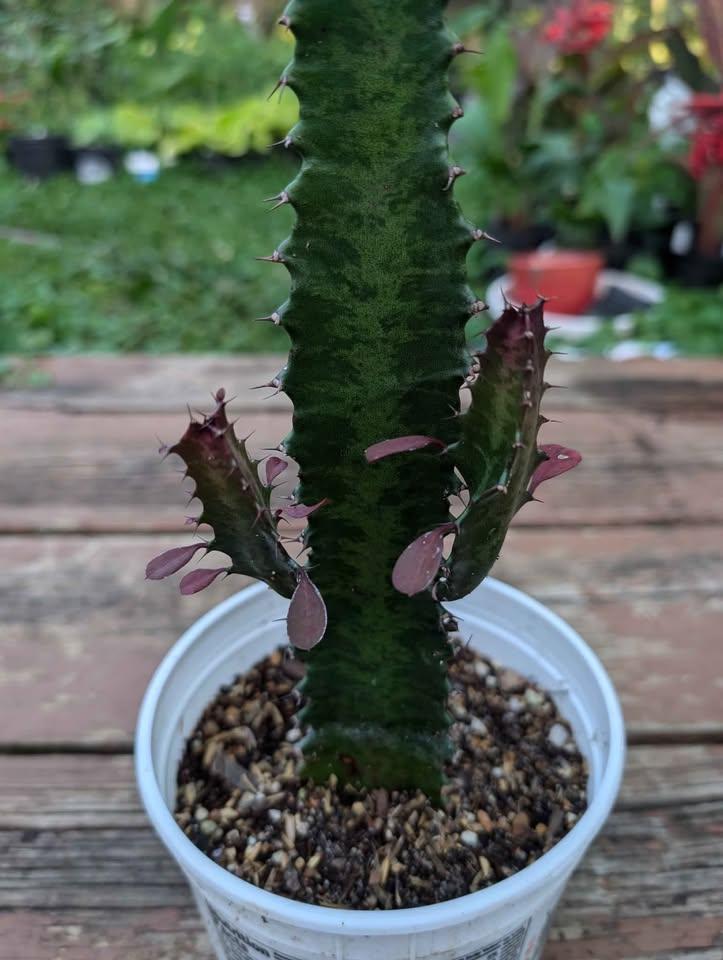In a nutshell, Euphorbia trigona is the name of the African Milk Tree.
Euphorbia trigona, also known as the African Milk Tree, is a tall, aesthetically pleasing succulent that originates in Central Africa. It belongs to the Euphorbia family, not the cactus family, despite its cactus-like appearance. Due to its quick vertical growth, triangular stems, and vibrant green or burgundy leaves, this plant is valued and widely used in succulent gardens, patios, and as an indoor plant.
This plant is hardy, drought-tolerant, and ideal for both novice and expert gardeners.
🌿 Botanical Overview
Euphorbia trigona is the scientific term.
Euphorbiaceae is the family.
Common Names: Cathedral Cactus, African Milk Tree, Friendship Cactus (even though it isn’t a real cactus)
Central Africa
Growth Behavior: Tall, erect, columnar succulent
Size:
Height: Up to 6–9 feet (1.8–2.7 meters) under optimal conditions
Spread: between one and two feet (30–60 cm)
Look and feel
Stems:
Stems with a triangular cross-section
vertical ridges covered with tiny thorns
green stalks with textures and vertical lines
Leaves:
Little, teardrop-shaped leaves sprout along the ridges.
The leaves and stems of the ‘Rubra’ or ‘Royal Red’ cultivars, which are typically bright green, may be reddish to dark burgundy in color.
Flowers: If ever, they bloom very seldom inside; the blooms are little and inconspicuous.
Needs for light
Indoors:
Thrives in bright, indirect light
Likes a window facing south or east
Prolonged harsh sunlight can cause sunburn, especially on young plants, but some direct sun can be tolerated.
outside:
filtered or partial sunlight is preferable
To avoid burning, gradually adjust to the full sun.
Leggy or uneven development might result from insufficient light.
🌡️ Temperature and humidity
Temperature:
Favors temperatures ranging from 18 to 30 degrees Celsius (65 to 85 degrees Fahrenheit).
not frost-resistant; keep away from temperatures under 10°C (50°F).
humidity:
Performs well in environments with moderate to low humidity.
No particular humidity requirements are necessary.
To avoid fungal problems, good ventilation is necessary.
💦 Water regimen
Season of Growth (Spring to Early Autumn):
Water when the top 2–3 inches of soil are dry
Water thoroughly, making sure that any extra water drains.
Although the frequency varies depending on the temperature, light, and pot size, it is usually every 10–14 days.
Winter Dormancy:
Water should be reduced to once every four to six weeks.
The plant needs little water and grows slowly.
The most frequent reason for failure is overwatering, which causes root rot and stem collapse.
The Needs of the Soil
Kind:
It must have soil that drains well.
Perfect combination:
half cactus and succulent soil
25% pumice or perlite
25% of it is made up of coarse sand.
pH: between neutral and somewhat acidic (6.0–7.0)
To prevent waterlogging, make sure pots have drainage holes.
Adding fertilizer
Fertilize in the spring and summer, when the plants are growing.
Apply a balanced, diluted cactus/succulent fertilizer.
feed once a month
When the plant is dormant in the winter, there is no need to fertilize it.
Maintenance & Pruning
pruning:
Cut to manage height or get rid of broken stems
The milky sap is poisonous and can irritate skin and eyes, so always use gloves.
To avoid infections, let cut surfaces dry and become callous.
Washing:
For improved light absorption, dust the stems once in a while.
For uniform development, rotate the plant on a regular basis.
🌿 Reproduction
Stem cuttings:
The best way to spread
Use a clean, sharp knife to cut a healthy portion of the stem.
Allow the cut to dry and callous over for 3–5 days.
Plant in soil that is dry and drains well.
Water lightly after a few days, when roots start to develop.
Due to the hazardous sap, always handle with caution.
Problems That Are Common
Excessive watering leads to root and stem rot.
Underwatering: can lead to leaf fall and stem wrinkling
Pests: Infrequently impacted by:
Mealybugs
Spider mites
Insects that scale
Use neem oil or insecticidal soap to treat.
Sunburn: White or brown patches on stems caused by excessive exposure to direct sunlight
⚠️ toxicity
The latex sap is white:
Toxic if eaten
Causes eye damage and skin irritation
Stay away from kids and animals.
When potting or chopping, always wear gloves.
🎍 Ornamental Application
Known for:
Tall statement plants for indoor use
Contemporary, simple style
Gardens in containers
Tropical or subtropical climates’ outdoor pots
It is an architectural focal point because of its high, graceful, candelabra-like growth.
✅ Summary
The African Milk Tree (Euphorbia trigona) is a low-maintenance, quick-growing succulent that adds vertical appeal and sculptural elegance. It may flourish both indoors and outdoors for many years, growing to remarkable heights if given the right care, including sufficient light, well-draining soil, and careful irrigation.
Office Plants, Succulents
African Milk Tree
₨999.00
African Milk Tree
Cactus-like euphorbia with upright branching and red-tinged stems—great for sunny corners and sculptural displays.





Reviews
There are no reviews yet.